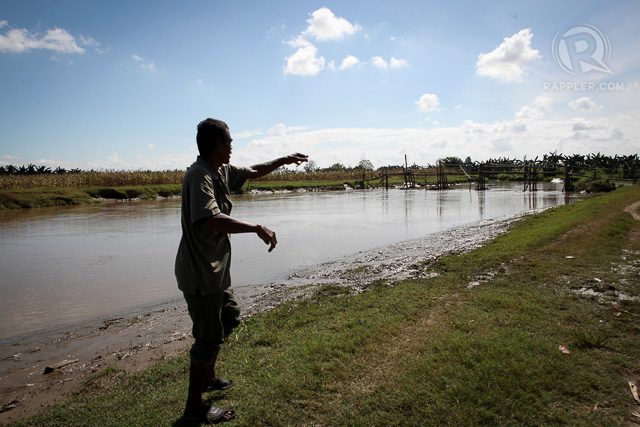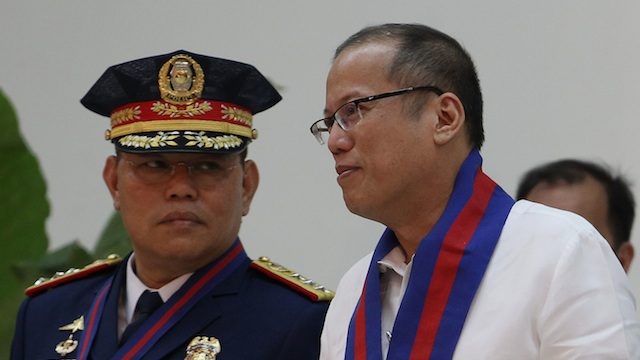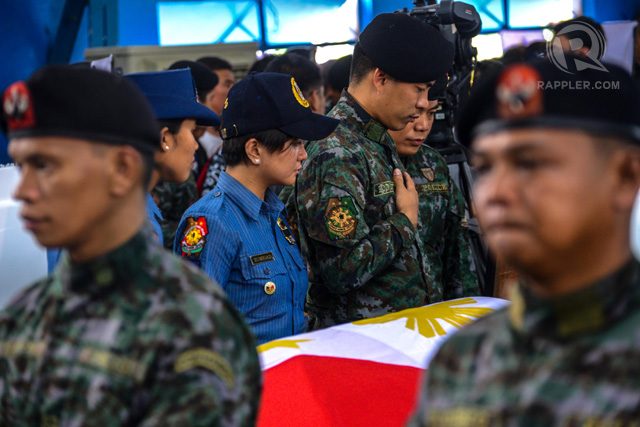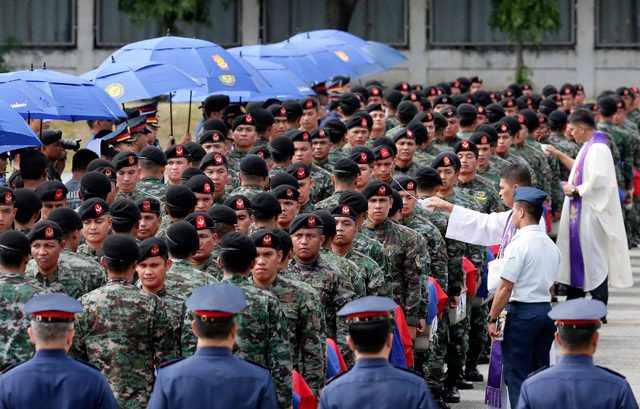SUMMARY
This is AI generated summarization, which may have errors. For context, always refer to the full article.

MANILA, Philippines – It was a “suicide” mission – with enemy combatants from all sides, pintakasi (free for all) a real threat, and a flat terrain that offered no cover or exit.
So why were Special Action Force (SAF) troopers, the Philippine National Police (PNP)’s elite striking force, brazen enough to push through with “Oplan Exodus?”
Based on their operation briefing and mission update for “Oplan Exodus,” a January 25 operation that saw 392 SAF troopers enter Mamasapano town in Maguindanao to neutralize two terrorists, the SAF were told – and fully expected – air and artillery support when push came to shove.
Investigation also showed that commanders from the Seaborne, the SAF’s most elite unit, had initial reservations about a Seaborne-only operation.
“There are indications that Napeñas may not have considered differing opinions raised by his subordinate commanders,” said a part of the police Board of Inquiry (BOI) report.
In the end, the troopers followed their commander.
“Since Napeñas had express instruction that there would be no abort criteria, team leaders were forced to execute the plan at all costs,” said the BOI report. (Read the full BOI report here)
It’s why the 55th Special Action Company (SAC), the second most elite unit in the SAF, was eventually assigned to be the “support effort” of the Seaborne for the operation. The two companies are typically paired together for operations. Its troopers are most familiar with each other and in many cases, are each other’s closest friends.
Napeñas’ assurances
SAF’s PowerPoint presentation, a copy of which was obtained by Rappler, lists down air and artillery support as a “critical” component in the operation should they be overwhelmed by enemy combatants.
Since the PNP has neither, it could only come from the Armed Forces of the Philippines (AFP).
In a January 9 briefing in Malacañang, President Benigno Aquino III asked those present – Purisima, Napeñas and PNP Intelligence Group head Senior Superintendent Fernando Mendez – to coordinate with the military prior to the operation.
The 3 said no, saying the Armed Forces of the Philippines (AFP) was “compromised.” The decision was then to inform the AFP “time on target,” or when the troops were already in the area. (READ: Don’t you trust the AFP? Aquino asked Purisima, Napeñas)
Parts of the BOI’s report, which was submitted to PNP OIC Deputy Director General Leonardo Espina on Thursday, March 12, said:
“[Napeñas] gave the operation troops his assurance that artillery or indirect fire support will be provided.”
– PNP Board of Inquiry report
“Based on interviews with SAF members, [sacked PNP SAF commander Police Director Getulio Napeñas] also gave the operation troops his assurance that artillery or indirect fire support will be provided. The assurance gave them the confidence to pursue the mission,” said the report.
But things did not work out as planned – or as promised – on January 25 when troopers encountered fighters from the Moro Islamic Liberation Front (MILF), its breakaway group the Bangsamoro Islamic Freedom Fighters (BIFF) and Private Armed Groups (PAGs) early in the morning.
Kept out of the loop, local miltary forces were unable to send help in the form of artillery or indirect fire support until late January 25, or more than 12 hours after the first bullet was shot.
At least 65 people, including 44 troopers from the 84th and 55th SAC, 18 MILF fighters, and 3 civilians died during one of the bloodiest days in PNP and SAF history.
Compartmentalized
The presentation for the operation, which contains over 100 slides, details the dangerous terrain that SAF troopers were going to see: plain fields with little to no cover, rivers, and rickety bridges.
When the 55th SAC – the designated support effort for the operation – was under assault by Muslim rebels, they had no cover. The most that the cornfields of Tukanalipao could offer was concealment, but barely.

It was new territory for the highly-trained commandos. None of the SAF companies deployed for “Oplan Exodus” were based in Maguindanao.
Napeñas specifically picked SAF companies that were not from the area. The reason? “Secrecy,” said one police source familiar with how special operations are conducted.
“Napeñas compartmentalized the operation – top and bottom,” noted another police official, who spoke with the surviving SAF troopers days after the operation.
But the most controversial among Napeñas’ decisions was his call to only inform the AFP of the operation “time on target,” or only after SAF troopers had entered the area.
“Napeñas gave instructions that the operation had no abort criteria.”
– PNP Board of Inquiry report
Napeñas himself admitted during a Senate hearing that secrecy was one of the reasons why he ultimately decided to keep the AFP out of the loop. The police general was wary of leaks which would have led to another aborted mission, implying that local military forces had compromised previous operations.
“Oplan Exodus” was the SAF’s 5th try in a row to get Marwan. And on their last try, there was no abort plan to speak of.
Disaster waiting to happen

Sources from the police explained the set-up was a recipe for disaster.
Napeñas’ presence in the Malacañang meeting on January 5 made it clear to Aquino that Napeñas was on top of the situation. Purisima’s and Aquino’s presence, on other hand, assured Napeñas that full support would be extended.
Aquino has since blamed Napeñas for the botched operation, insisting that the police general failed to follow his orders to coordinate with the AFP and OIC PNP Deputy Director Leonardo Espina, who took over after Purisima’s suspension.
“It’s clear that he fooled me,” Aquino said on March 9.
But Napeñas argued he only kept Espina and Interior Secretary Manuel Roxas II out of the loop under the orders of Purisima.
Purisima also told Napeñas that he would “take care of” informing AFP chief General Gregorio Catapang, Jr., who is Purisima’s classmate from Philippine Military Class of 1981.
Purisima did this in the early hours of January 25. What followed was a flurry of text messages and phone calls among Catapang, Purisima, Espina, Westmincom chief Lieutenant General Rustico Guerrero, 6th Infantry Division chief Major General Edmundo Pangilinan, and Napeñas.
The BOI, in its report, said Purisima, then already serving a suspension order, had no business taking part in the planning and execution of the operation.
Scenario: More than 1,000 rebels
The briefing also warned troopers they would be entering a community where MILF members, or at least those sympathetic to their cause, resided.
The target area – where bomb maker and terrorist Zulkifli bin Hir, alias “Marwan,” and Abdul Basit Usman resided – was also surrounded by possibly hostile forces.
Surrounding Marwan and Usman’s huts were areas teeming with BIFF fighters and private armies. Nearby was the MILF’s 105th, 118th, and 106th base commands.
The SAF, based on the mission update, could be up against close to 400 enemy combatants in the immediate area of operation and about 700 in the surrounding areas. All in all, some 1,100 armed persons were estimated to be in barangay Tukanalipao.
The figures don’t include the number of armed men tasked to guard Marwan and Usman themselves.
“It looked like a suicide mission,” said a police source.

To be sure, the SAF troopers understood how risky the operation was.
The SAF, in fact, had planned at least 4 different scenarios to capture Marwan and Usman: one with several SAF companies, another involving only the elite Seaborne Company, one with the AFP, and another with the AFP’s Joint Special Operations Group (JSOG). – Rappler.com
Related stories on the BOI report:
Aquino broke chain of command – BOI
Aquino has no liability, says Roxas
6 Americans gave real-time info to SAF
Police probers: Purisima acted without authority
Add a comment
How does this make you feel?

There are no comments yet. Add your comment to start the conversation.